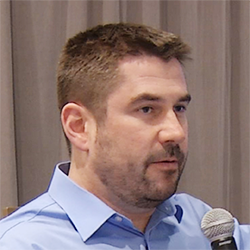In this video Dr. Singer introduces and discusses cardiovascular adrenergic function as a helpful component of autonomic screening.
Alright, on to adrenergic function, the last component of the autonomic reflex screen. And again, there are many tests you can utilize to assess adrenergic function. This is not a comprehensive list, but a list of the more commonly used methods. We use routinely those two, sometimes the third one here listed and again why do we use those? Because again the same reasons: sensitivity, specificity, and reproducibility, etc. that I mentioned before.
So, in order to understand and be able to interpret adrenergic function and dysfunction using the Valsalva maneuver, you have to understand a little bit about the physiology that’s underlying the blood pressure responses to the Valsalva maneuver. It’s actually fairly simple if you split it up into the different phases of the maneuver. So, there’s phase 1, which is purely a mechanical phase. You blow into that bugle, you increase intrathoracic pressure, and there’s a fluid shift from central to peripheral compartments of the body and there’s a transient brief rise in blood pressure that you detect when we read the blood pressure from the finger, pure mechanical. Early phase 2 is the subsequent decline in blood pressure that is caused again, you have an increased intrathoracic pressure; therefore, you have decreased venous return, decreased cardiac filling, decreased stroke volume and your blood pressure continues to go down and it would continue to do so unless something happened and this is where the autonomic nervous system comes in. Now it’s getting interesting, that’s late phase 2. Baroreceptors sense the drop in blood pressure, and that results in vagal withdrawal and sympathetic stimulation. Your peripheral persistence increases, your cardiac output increases, your heart rate increases and as a result of that, blood pressure stops falling and eventually goes back to baseline while still blowing, while the thoracic pressure is still increased. Then once the subject stops blowing, you get phase 3, which is basically the mirror image of phase 1, a mechanical phase, basically pressure shifts back to the central compartment briefly and then increased cardiac output is being forced against a pre-constricted vascular bed and you can overshoot, blood pressure rises above baseline and does so for a number of seconds before going back to baseline, this is phase 4. So, to summarize all this, the two components of the Valsalva maneuver that we’re really interested in are late phase 2 and phase 4. Those two reflect adrenergic function. The rest is sort of interesting but doesn’t really give you much information about the autonomic nervous system.
And that can be nicely shown in studies where we look at normal controls with mild, moderate and severe adrenergic impairment and you can progressively see late phase 2 disappear and you can progressively see phase 4 disappear and become actually sort of a negative slow passive return or recoil back to baseline rather than overshoot. Again, there are number of factors just like the ones before that can affect blood pressure responses to the Valsalva maneuver and those are listed here. Again, I cannot emphasize medications enough that the patient needs to be tapered off before autonomic testing.
A few more examples of a normal response here on top. This is actually the beat-to-beat recording, which shows you the physiology. Someone with modest adrenergic impairment and in someone with severe adrenergic failure, rate took some 30 seconds for blood pressure to return back to baseline. Our focus on grading the severity of adrenergic failure is really shifted from just looking at late phase 2 to looking at the time it takes for blood pressure to recover following the maneuver. We actually hypothesized that we can quantify that and have a quantifiable measure of adrenergic baroreflex sensitivity by looking at the blood pressure recovery or indices we derive from blood pressure recovery following the maneuver and in fact, we looked at groups of patients with different severity of adrenergic failure in normal controls and have a nice gradation, a nice separation of those groups, by utilizing simply blood pressure recovery time. We have normative values established now and published and that’s a very helpful tool in assessing and quantifying adrenergic failure, and it correlates with my chronography.
Another interesting association of PRT is that with the orthostatic blood pressure drop. We’ve shown that if your pressure recovery time is greater than 7 seconds, there is 87% sensitivity and over 90% specificity that the person will have orthostatic hypotension on head up tilt. This is kind of nice way of knowing when to expect someone to have orthostatic hypotension before you even tilt them up.

Wolfgang Singer, MD
Associate Professor of Neurology
Mayo Clinic Rochester, MN































